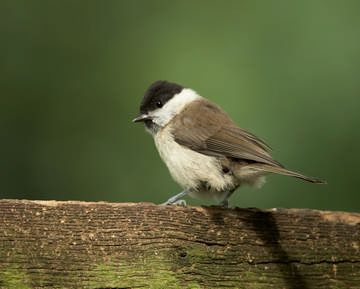
Marsh Tit © Richard Steel
This is the ‘brown tit’ of mature woodland, especially with oak or beech, and their habitat preference – very different from that of the Willow Tit – is well shown by the codes submitted by observers in this survey. Nearly three-quarters of the records (22 out of 30) were in broadleaved woodland (A1), with three in mixed woodland (A3), one each in waterlogged broadleaved and mixed woodland (A4 and A6), and three others. Recent study has shown that the characteristics of the shrubs, especially at heights of 2-4 m, underneath the tall trees are most important for Marsh Tits (Hinsley et al 2007). Damage to the shrub layer, by deer, by shading out by canopy closure and by managed clearance of shrub cover, may underlie the long-term sustained drop in the abundance of Marsh Tits. They are now on the Red List of species of conservation concern, following a sustained fall in their national population ever since BTO census work started in the 1960s. From a nadir in 1998, there has been a small rise, leaving the national population index with a drop of 20% between our two Atlases, from 1984 to 2004.
Detailed demographic work suggests that the decline may have been driven by low annual survival and that neither increased predation nor interspecific competition is responsible (Siriwardena 2006). Nesting success has improved during the period of decline. They defend territories all year round, from 2-8 ha in size, within which they satisfy all of their annual needs, and they are seldom found in woods smaller than 1 ha (Hinsley et al 1995, Broughton et al 2006). Marsh Tits are the lowest in pecking order when competing for nest-holes, and they choose small holes in mature trees, close to the ground, that are probably unattractive to other species (Nilsson 1984). They start laying in mid- or late-April, becoming earlier with climate change, and the average brood of around 7 chicks fledges in early June. Their summer diet is dominated by adult insects, especially moths, bugs, springtails and beetles, and Marsh Tits depend much less on the insect larvae associated with oaks than other tits; they obtain most of their food from the understorey vegetation or from low in the canopy.
The species was found in 160 tetrads in the First Atlas, but only 30 tetrads in this survey, only four of them with proven breeding. The ‘change’ map shows that locations that were occupied in the First Atlas and still now include much of the county’s scarce mature woodland: the lower Weaver valley around Aston, the Wych valley, the Eaton estate and the Peckforton area. It is missing from the north of Cheshire and from Wirral. The loss of Marsh Tits in Cheshire is much more than would have been expected from a 20% drop in their national population, and this is probably a reflection of changes in abundance and distribution being more obvious at the edge of a species’ range. In its national distribution, Marsh Tit has an obvious gap in the Mersey valley, and the Lancashire and North Merseyside tetrad breeding atlas (1997-2000) showed only one record in Lancashire within 25km of the Cheshire boundary.
Some birdwatchers have difficulty in distinguishing the two species of ‘brown tits’ although their calls are completely different, and the map omits records from two tetrads in which the observer was uncertain of the identification. Now that they are both scarce species in Cheshire, they have completely separated in their local distribution: during this Atlas survey there was no tetrad in which Marsh Tit and Willow Tit were both recorded in the breeding season.
Twenty years ago Marsh Tit was a relatively widespread bird, with a Cheshire and Wirral population probably under-estimated at 150-200 pairs. In this survey, most of the records were of single birds, or pairs, and the county population is unlikely to exceed 50 pairs. The reasons for this drop are probably worthy of professional study. The oft-quoted cause, loss of under-storey from excessive browsing by deer, cannot be the reason in our county where feral deer are still relatively scarce.
Sponsored by Paul Morris

